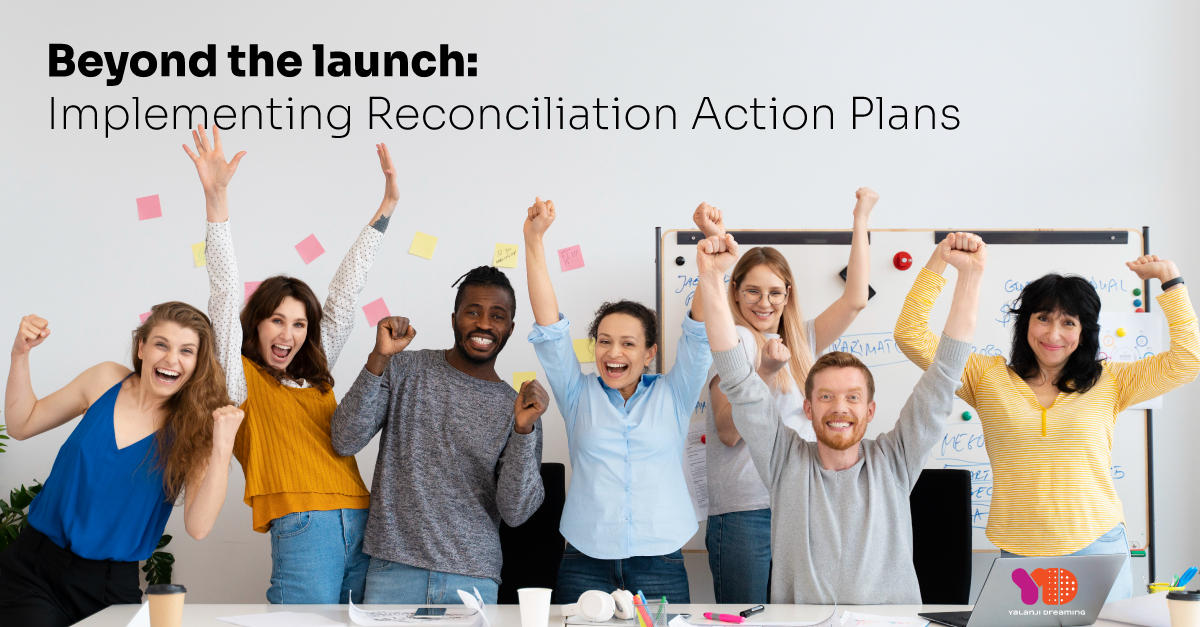Almost 85% of our clients do not have a strategy to internalise and implement their Reconciliation Action Plans beyond the launch.
After venturing out into running my own social impact consultancy services, I’ve been fortunate to offer my experienced advisory services to many clients across Australia to help influence and guide their organisations.
After reviewing all my client notes, and specifically focusing mainly on the needs assessments carried out on my clients, an interesting trend was clearly showing its face; Reconciliation Actions Plans (RAPs) have an awesome front end (they pack in a lot of punch), but beyond the RAP Launch there was radio silence.
It was clear that at the forefront, organisations were adequately resourcing the development of their RAPs, ample people power, approvals and governance models were well established, and a clear launch of the RAP to promote to Australia the commitment of the organisation with Reconciliation.
However, once the launch of RAP had subsided, it appeared that this well developed, and initially perfectly executed RAP became a document that was now embedded in the shadows of a dot.com website gathering dust and slowly becoming a forgotten dream.
So, what’s the problem?
After consulting with my clients, it was evident that there were a few missing pieces that were left out of the Reconciliation recipe so to speak.
How do we internalise the identified targets and objectives of our RAP?
The simplest solution is through the development of a RAP Implementation Strategy, or an overarching Australian Indigenous Strategy. This specific document is your internal guidance on how to activate the RAP targets and objectives. It outlines expectations and accountabilities, it aligns business units and departments, and clearly articulates how to measure and evaluate your RAP.
From Yalanji Dreaming’s initial 6 months of consulting, almost 85% of our clients do not have a strategy to internalise and implement their RAPs. Generally, this is due to putting in all the effort up front in the development and launching of the RAP. However, once it is time to report back to Reconciliation Australia on how everything is tracking, it becomes quite apparent that the RAP has become an afterthought and a massive last second effort is required by the organisation to reach a said target.
All this does is exhaust the organisation and leaves them trying to catch their tails so to speak. As I mentioned earlier, this is when an organisation wipes the dust of the RAP – and at that point, the RAP has lost its true meaning and intent.
We truly believe in Reconciliation as an organisation, but our employees won’t engage, they just won’t buy in. What do we do?
Straight up, your employees have had no part in the development of the RAP. Generally, it’s the senior leadership team and RAP Working Group that have developed the creative objectives and targets for the organisation. However, the most import cohort who were not engaged, were your employees – the lifeblood of your organisation.
Fundamentally, a RAP is not aimed at promoting the great things you do externally in the Indigenous space, but it’s about supporting your workforce on their own individual journeys of Reconciliation.
When you look at your employees, they already have predisposed ideas about Indigenous Australia. Often this is due to the environment they were raised within, their primary and secondary education, their peers, and their friends and family. This is known as their sphere of influence.
So, the question above should really be – how do I support my employees in their own Reconciliation journey? The organisation has an inherent duty to support an employee in understanding their own personal journey of Reconciliation. Where do they fit? How did they contribute to the current snapshot of inequalities within Australia, and how can they help to make Australia as a whole a Reconciled nation?
The next question is – how do you challenge or change employees predisposed ideas of Reconciliation and Indigenous Australia? Education my friends… education. And how do we educate? Through clear and engaging communications.
The simplest solution to the questions identified within this section is through a well-developed RAP Communications Strategy (or plan). We need to drip feed educational and truth setting information about Australia’s Indigenous history, we need to articulate the who what when where and why’s, and we need to be able to take an employee on the organisations RAP journey to promote a sense of ownership. We need to make the employee feel as though they directly contributed to a RAP success.
To summarise the above, I believe there are good intentions within the organisations commitment to developing a RAP, but unfortunately the implementation of said RAP, takes a back seat.
There are times where, as an Indigenous man, I often question if a RAP is merely a Brand and Reputation exercise to showcase and spruce and ‘work we do in the Indigenous space’, and there are times where I engage with a client who generally just need some advice and guidance and can clearly see the good intentions at heart.
Externally communicating your commitment to Reconciliation via a RAP and then not delivering or achieving your identified targets and objectives can often result in three critical issues for an organisation:
- Negative public sentiment and a direct result on damaged brand and reputation
- Removal from Reconciliation Australia’s RAP Network, again resulting in damaged brand and reputation.
- Negative backlash from Australian Indigenous stakeholders.
Suffice to say, the additional steps identified below will mitigate the risk of the above happening.
My recommendations are fairly simple:
- When developing a RAP, be considerate of your largest audience; your employees. Remember that you have a responsibility to support and educate your employees on Reconciliation, and to help your employees understand where they fit within Reconciliation. As you engage your workforce to become strong advocates for Reconciliation, you will find that the ownership of the RAP no longer falls on the shoulders of the RAP Working Group – but you will have a large army at the call to assist at any time (RAP Champions).
- Develop a robust internal RAP Implementation Strategy. This ensures that the RAP doesn’t fall off the agenda. Ensure your strategy outlines expectations, accountabilities, employees, governance, communications, and evaluation. Ensure that the RAP connects with all your internal departments and business units so that they understand how they play an important part in the implementation of the RAP.
- Develop a RAP Communications Strategy. This document needs to be split for internal and external audiences. Ensure that there is a good drum beat of communications linked to your RAP but also broader materials to educate your employees. Search out for those opportunities for employees to engage in Reconciliation activities within the broader community and consider the development of a Cultural Immersion Program for your senior leadership team who can become internal role models for the workforce. Remember to celebrate your RAP successes and communicate these back into the business (and externally if relevant).
By closing out the few additional steps above, the RAP can become so much more than just some identified targets in a document. It has the real opportunity to reshape and influence workforce culture and become a mechanism to create true advocates for Reconciliation. When thinking about one of your employees sphere of influence, the heart of Reconciliation continues now beyond the workplace, it enters the broader community, and this is where true change begins.
Please reach out to me directly if you would like a free 30-minute consultation where I can provide guidance and advice on any of the above topics I have discussed. I am open to supporting your organisation develop any of the above-mentioned strategies.
I am truly inspired when organisations listed to the expertise I have to offer and take positive action to make Reconciliation something very intimate and meaningful.
Contact information:
Yalanji Dreaming
Steven Pelham, Director
e: info@yalanjidreaming.com
m: 0435 151 084
w: www.yalanjidreaming.com


No responses yet